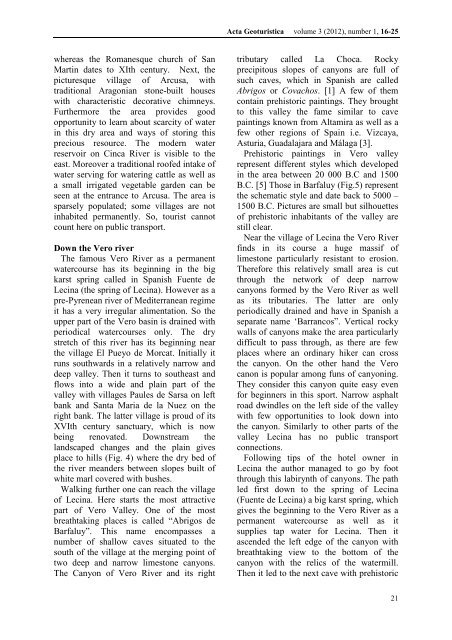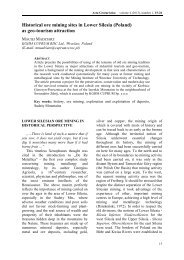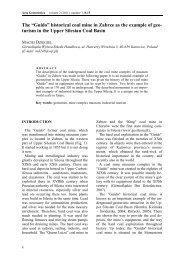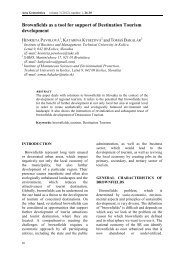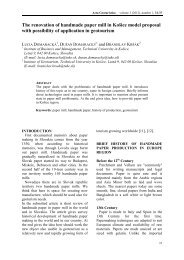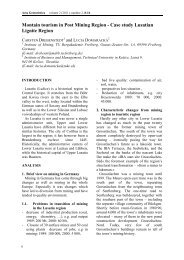Interweaving Geological and Cultural Heritages ... - Acta Geoturistica
Interweaving Geological and Cultural Heritages ... - Acta Geoturistica
Interweaving Geological and Cultural Heritages ... - Acta Geoturistica
Create successful ePaper yourself
Turn your PDF publications into a flip-book with our unique Google optimized e-Paper software.
<strong>Acta</strong> <strong>Geoturistica</strong> volume 3 (2012), number 1, 16-25<br />
whereas the Romanesque church of San<br />
Martin dates to XIth century. Next, the<br />
picturesque village of Arcusa, with<br />
traditional Aragonian stone-built houses<br />
with characteristic decorative chimneys.<br />
Furthermore the area provides good<br />
opportunity to learn about scarcity of water<br />
in this dry area <strong>and</strong> ways of storing this<br />
precious resource. The modern water<br />
reservoir on Cinca River is visible to the<br />
east. Moreover a traditional roofed intake of<br />
water serving for watering cattle as well as<br />
a small irrigated vegetable garden can be<br />
seen at the entrance to Arcusa. The area is<br />
sparsely populated; some villages are not<br />
inhabited permanently. So, tourist cannot<br />
count here on public transport.<br />
Down the Vero river<br />
The famous Vero River as a permanent<br />
watercourse has its beginning in the big<br />
karst spring called in Spanish Fuente de<br />
Lecina (the spring of Lecina). However as a<br />
pre-Pyrenean river of Mediterranean regime<br />
it has a very irregular alimentation. So the<br />
upper part of the Vero basin is drained with<br />
periodical watercourses only. The dry<br />
stretch of this river has its beginning near<br />
the village El Pueyo de Morcat. Initially it<br />
runs southwards in a relatively narrow <strong>and</strong><br />
deep valley. Then it turns to southeast <strong>and</strong><br />
flows into a wide <strong>and</strong> plain part of the<br />
valley with villages Paules de Sarsa on left<br />
bank <strong>and</strong> Santa Maria de la Nuez on the<br />
right bank. The latter village is proud of its<br />
XVIth century sanctuary, which is now<br />
being renovated. Downstream the<br />
l<strong>and</strong>scaped changes <strong>and</strong> the plain gives<br />
place to hills (Fig. 4) where the dry bed of<br />
the river me<strong>and</strong>ers between slopes built of<br />
white marl covered with bushes.<br />
Walking further one can reach the village<br />
of Lecina. Here starts the most attractive<br />
part of Vero Valley. One of the most<br />
breathtaking places is called “Abrigos de<br />
Barfaluy”. This name encompasses a<br />
number of shallow caves situated to the<br />
south of the village at the merging point of<br />
two deep <strong>and</strong> narrow limestone canyons.<br />
The Canyon of Vero River <strong>and</strong> its right<br />
tributary called La Choca. Rocky<br />
precipitous slopes of canyons are full of<br />
such caves, which in Spanish are called<br />
Abrigos or Covachos. [1] A few of them<br />
contain prehistoric paintings. They brought<br />
to this valley the fame similar to cave<br />
paintings known from Altamira as well as a<br />
few other regions of Spain i.e. Vizcaya,<br />
Asturia, Guadalajara <strong>and</strong> Málaga [3].<br />
Prehistoric paintings in Vero valley<br />
represent different styles which developed<br />
in the area between 20 000 B.C <strong>and</strong> 1500<br />
B.C. [5] Those in Barfaluy (Fig.5) represent<br />
the schematic style <strong>and</strong> date back to 5000 –<br />
1500 B.C. Pictures are small but silhouettes<br />
of prehistoric inhabitants of the valley are<br />
still clear.<br />
Near the village of Lecina the Vero River<br />
finds in its course a huge massif of<br />
limestone particularly resistant to erosion.<br />
Therefore this relatively small area is cut<br />
through the network of deep narrow<br />
canyons formed by the Vero River as well<br />
as its tributaries. The latter are only<br />
periodically drained <strong>and</strong> have in Spanish a<br />
separate name ‘Barrancos”. Vertical rocky<br />
walls of canyons make the area particularly<br />
difficult to pass through, as there are few<br />
places where an ordinary hiker can cross<br />
the canyon. On the other h<strong>and</strong> the Vero<br />
canon is popular among funs of canyoning.<br />
They consider this canyon quite easy even<br />
for beginners in this sport. Narrow asphalt<br />
road dwindles on the left side of the valley<br />
with few opportunities to look down into<br />
the canyon. Similarly to other parts of the<br />
valley Lecina has no public transport<br />
connections.<br />
Following tips of the hotel owner in<br />
Lecina the author managed to go by foot<br />
through this labirynth of canyons. The path<br />
led first down to the spring of Lecina<br />
(Fuente de Lecina) a big karst spring, which<br />
gives the beginning to the Vero River as a<br />
permanent watercourse as well as it<br />
supplies tap water for Lecina. Then it<br />
ascended the left edge of the canyon with<br />
breathtaking view to the bottom of the<br />
canyon with the relics of the watermill.<br />
Then it led to the next cave with prehistoric<br />
21


